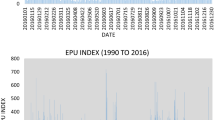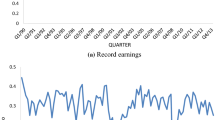Abstract
This study investigates how real earnings management (REM) in the initial public offering (IPO) year affects long-run post-IPO market performance. The empirical results show that the effect of REM on a firm’s stock returns varies with the forms of REM. Abnormal production costs are positively associated with long-run returns, whereas abnormal cuts in discretionary expenses are negatively associated with long-run returns. These results suggest that investors are not fully aware of the implications of REM and initially undervalue or overvalue the firm based on different REM activities. Further, this study examines the long-run role of the media in the capital market by examining the impact of media coverage on the consequences of IPO firms’ REM practices. The results indicate that the associations between REM and stock returns become weaker if the IPO firm is more visible through the media. Additional analyses show that retail investors are more likely to initially misprice REM activities and be influenced by media information. Compared with media coverage, audit quality or analyst following has a relatively less pronounced effect on the consequences of REM activities. These findings imply that media coverage appears to mitigate the influence of REM on stock returns, facilitating market efficiency after a firm’s IPO in the long run.







Similar content being viewed by others
Notes
The average aggregate earnings management is defined as the average country ranking of EM1, EM2, EM3, and EM4. EM1 is defined as the median ratio in country i of the firm-level standard deviations of operating earnings over the cash flow from operating activities (both scaled by lagged total assets), multiplied by -1. EM2 is defined as the cross-sectional correlation in country i between the change in accruals and change in cash flows from operating activities (both scaled by lagged total assets), multiplied by − 1. EM3 is defined as the median ratio in country i of the absolute value of accruals over the absolute value of cash flow from operating activities. EM4 is defined as the ratio in country i of the number of firms reporting small profits over the sum of the number of firms reporting small losses and profits. A smaller profit (loss) is defined as a value of net earnings scaled by lagged total assets in the range [0, 0.01] ([− 0.01, 0]).
The average earnings opacity is defined as the average country i decile ranking across EM2, EM4, and earnings aggressiveness, where earnings aggressiveness is the median ratio in country i of total accruals over the lagged total assets.
The CSMAR and the RESSET are two leading economic and financial data providers in China.
China Securities Regulatory Commission suspended IPO from November 2012 to November 2013, so only two firms were listed in 2013. These two IPOs are excluded from the sample due to a lack of necessary data to estimate REM measures.
The IPO firms and other firms conducting an IPO or SEO firm in the year are not included in the regression.
The Chinese listed firms are required to release their audited annual reports by the end of the following April.
In untabulated tests, I investigate whether the effect of media coverage varies with the types of media sources. I classified media into two categories: state-controlled and market-oriented, based on the ownership structure and control rights shown in the company disclosure, newspapers’ websites, and government press releases. The results report that the effect of media coverage on the relationship between REM activities and long-run stock returns is more pronounced when the news reports are from market-oriented media. One possible reason is that information from the market is more comprehensive and accurate (You et al., 2018), improving investors’ understanding of managerial earnings manipulation.
In the untabulated analysis, I test the relationship between REM and subsequent operating performance (∆ROA) using the other three REM measures (N_ABDISX, N_ABCFO, and TREM). The results report negative coefficients of these measures, qualitatively similar to those reported in Table 4. These results support the expectation that investors are not fully aware of these REM activities and initially overvalue the firm based on these REM activities, leading to negative associations between these REM activities and subsequent stock returns.
References
Aharony, J., Lin, C.-J., & Loeb, M. P. (1993). Initial public offerings, accounting choices, and earnings management. Contemporary Accounting Research, 10(1), 61–81.
Ayers, B. C., & Freeman, R. N. (2003). Evidence that analyst following and institutional ownership accelerate the pricing of future earnings. Review of Accounting Studies, 8(1), 47–67.
Balsam, S., Krishnan, J., & Yang, J. S. (2003). Auditor industry specialization and earnings quality. Auditing: A Journal of Practice & Theory, 22(2), 71–97.
Barton, J., & Simko, P. J. (2002). The Balance Sheet as an Earnings Management Constraint. The Accounting Review, 77(s-1), 1–27.
Bartov, E., Givoly, D., & Hayn, C. (2002). The rewards to meeting or beating earnings expectations. Journal of Accounting and Economics, 33(2), 173–204.
Bergstresser, D., & Philippon, T. (2006). CEO incentives and earnings management. Journal of Financial Economics, 80(3), 511–529.
Beyer, B. D., Nabar, S. M., & Rapley, E. T. (2018). Real earnings management by benchmark-beating firms: Implications for future profitability. Accounting Horizons, 32(4), 59–84.
Boulton, T., Smart, S. B., & Zutter, C. J. (2011). Earnings quality and international IPO underpricing. The Accounting Review, 86, 483–505.
Bushee, B. J., Core, J. E., Guay, W. R., & Hamm, S. J. W. (2009). The Role of the Business Press as an Information Intermediary. Journal of Accounting Research, 48(1), 1–19.
Bushee, B., Cedergren, M., & Michels, J. (2020). Does the media help or hurt retail investors during the IPO quiet period? Journal of Accounting and Economics, 69(1), 101261.
Chahine, S., Mansi, S., & Mazboudi, M. (2015). Media news and earnings management prior to equity offerings. Journal of Corporate Finance, 35, 177–195.
Chang, S.-C., Chung, T.-Y., & Lin, W.-C. (2010). Underwriter reputation, earnings management and the long-run performance of initial public offerings. Accounting & Finance, 50(1), 53–78.
Chen, Y., Cheng, C. S. A., Li, S., & Zhao, J. (2021). The monitoring role of media: evidence from earnings management. Journal of Business Finance & Accounting, 48(3–4), 533–563.
Cohen, D. A., Dey, A., & Lys, T. Z. (2008). Real and accrual-based earnings management in the pre- and post-Sarbanes-Oxley periods. The Accounting Review, 83(3), 757–787.
Cohen, D. A., & Zarowin, P. (2010). Accrual-based and real earnings management activities around seasoned equity offerings. Journal of Accounting and Economics, 50(1), 2–19.
Collins, D. W., Gong, G., & Hribar, P. (2003). Investor sophistication and the mispricing of accruals. Review of Accounting Studies, 8(2), 251–276.
Dai, L., Parwada, J. T., & Zhang, B. (2015). The governance effect of the media’s news dissemination role: Evidence from insider trading. Journal of Accounting Research, 53(2), 331–366.
Dai, L., Shen, R., & Zhang, B. (2021). Does the media spotlight burn or spur innovation? Review of Accounting Studies, 26(1), 343–390.
Dai, Z., Yong, M., & Odin, N. (2016). A Portrait of the individual investor: Survey evidence from different provinces in China. Available at SSRN 2722051.
Darrough, M., & Rangan, S. (2005). Do insiders manipulate earnings when they sell their shares in an initial public offering? Journal of Accounting Research, 43(1), 1–33.
Dechow, P. M., Kothari, S. P., & Watts, R. L. (1998). The relation between earnings and cash flows. Journal of Accounting and Economics, 25(2), 133–168.
Dechow, P. M., Sloan, R. G., & Sweeney, A. P. (1995). Detecting earnings management. The Accounting Review, 70(2), 193–225.
Drake, M. S., Guest, N. M., & Twedt, B. J. (2014). The Media and Mispricing: The Role of the Business Press in the Pricing of Accounting Information. The Accounting Review, 89(5), 1673–1701.
Eng, L. L., & Lin, Y. C. (2012). Accounting quality, earnings management and cross-listings: evidence from China. Review of Pacific Basin Financial Markets and Policies, 15(02), 1250009.
Fang, L., & Peress, J. (2009). Media coverage and the cross-section of stock returns. The Journal of Finance, 64(5), 2023–2052.
Fedyk, T., Singer, Z., & Soliman, M. (2017). The sharpest tool in the shed: IPO financial statement management of STEM vs non-STEM firms. Review of Accounting Studies, 22(4), 1541–1581.
Francis, J. R., & Yu, M. D. (2009). Big 4 office size and audit quality. The Accounting Review, 84(5), 1521–1552.
Gao, Y. (2010). What comprises IPO initial returns: Evidence from the Chinese market. Pacific-Basin Finance Journal, 18(1), 77–89.
Graham, J. R., Harvey, C. R., & Rajgopal, S. (2005). The economic implications of corporate financial reporting. Journal of Accounting and Economics, 40(1–3), 3–73.
Gunny, K. A. (2010). The relation between earnings management using real activities manipulation and future performance: Evidence from meeting earnings benchmarks: Real activities manipulation and future performance. Contemporary Accounting Research, 27(3), 855–888.
He, J., Wei, M., & Liu, F. (2008). Benefit transfer, media coverage, and corporate governance: The casestudy of Wuliangye. Management World, 10, 141–150. (in Chinese).
Jones, J. J. (1991). Earnings management during import relief investigations. Journal of Accounting Research, 29(2), 193–228.
Li, X. (2010). Real earnings management and subsequent stock returns. Available at SSRN 1679832.
Liu, B., & McConnell, J. J. (2013). The role of the media in corporate governance: Do the media influence managers’ capital allocation decisions? Journal of Financial Economics, 110(1), 1–17.
Lys, T., & Sohn, S. (1990). The association between revisions of financial analysts’ earnings forecasts and security-price changes. Journal of Accounting and Economics, 13(4), 341–363.
Meng, Y. (2020). An empirical study on the influence of media attention on real earnings management. In 6th International Conference on Humanities and Social Science Research (ICHSSR 2020), 228–233.
Peress, J. (2014). The media and the diffusion of information in financial markets: Evidence from newspaper strikes. The Journal of Finance, 69(5), 2007–2043.
Ritter, J. R., & Welch, I. (2002). A review of IPO activity, pricing, and allocations. The Journal of Finance, 57(4), 1795–1828.
Rosenbaum, P. R., & Rubin, D. B. (1985). Constructing a control group using multivariate matched sampling methods that incorporate the propensity score. The American Statistician, 39(1), 33–38.
Roychowdhury, S. (2006). Earnings management through real activities manipulation. Journal of Accounting and Economics, 42(3), 335–370.
Roychowdhury, S., Kothari, S. P., & Mizik, N. (2012). Managing for the moment: the role of real activity versus accruals earnings management in SEO Valuation. Working Paper.
Shen, Z., Coakley, J., & Instefjord, N. (2014). Earnings management and IPO anomalies in China. Review of Quantitative Finance and Accounting, 42(1), 69–93.
Srivastava, A. (2019). Improving the measures of real earnings management. Review of Accounting Studies, 24(4), 1277–1316.
Teoh, S. H., Welch, I., & Wong, T. J. (1998). Earnings management and the long-run market performance of initial public offerings. The Journal of Finance, 53(6), 1935–1974.
You, J., Zhang, B., & Zhang, L. (2018). Who captures the power of the pen? The Review of Financial Studies, 31, 43–96.
Funding
This research did not receive any specific Grant from funding agencies in the public, commercial, or not-for-profit sectors.
Author information
Authors and Affiliations
Corresponding author
Ethics declarations
Conflict of interest
The author declares no conflict of interest.
Ethical approval
The author declares that the experiments comply with the current laws of the country in which they were performed.
Additional information
Publisher's Note
Springer Nature remains neutral with regard to jurisdictional claims in published maps and institutional affiliations.
Appendix
Rights and permissions
Springer Nature or its licensor (e.g. a society or other partner) holds exclusive rights to this article under a publishing agreement with the author(s) or other rightsholder(s); author self-archiving of the accepted manuscript version of this article is solely governed by the terms of such publishing agreement and applicable law.
About this article
Cite this article
Yu, D. Media Coverage, Real Earnings Management, and Long-Run Market Performance: Evidence from Chinese IPOs. Asia-Pac Financ Markets 30, 729–760 (2023). https://doi.org/10.1007/s10690-022-09396-2
Accepted:
Published:
Issue Date:
DOI: https://doi.org/10.1007/s10690-022-09396-2




